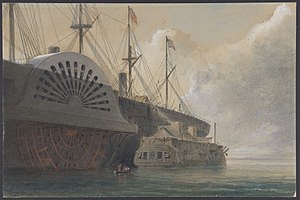 The old Frigate Iris with her freight of Cable alongside Great Eastern at Sheerness in 1865. The cable passing from the hulk to Great Eastern.
| |
| History | |
|---|---|
| Name | HMS Iris |
| Namesake | Iris (mythology) |
| Ordered | 20 February 1837[1] |
| Builder | Devonport Dockyard |
| Cost | £17,233 |
| Laid down | September 1838[1] |
| Launched | 14 July 1840 |
| Decommissioned | 16 October 1869 |
| Fate | Sold as a cable vessel |
| General characteristics | |
| Class and type | Spartan-class sixth-rate frigate (later "corvette") |
| Displacement | 911 33⁄94 (bm)[1] |
| Length |
|
| Beam | 40 ft 6+1⁄4 in (12.351 m)[1] |
| Depth of hold | 10 ft 9 in (3.28 m)[1] |
| Sail plan | Full-rigged ship |
| Complement | 240 |
| Armament | |
HMS Iris was a 26-gun sixth-rate frigate launched on 14 July 1840 from Devonport Dockyard. She spent some time with the West Africa Squadron suppressing the slave trade and later with the East Indies Station was involved in operations in Borneo. Iris was the first flagship of the Australia Station between 1859 and 1861 during which time she participated in the First Taranaki War.[2] In 1864 she was extensively modified to allow her to ferry transatlantic telegraph cable to the cable-laying ship Great Eastern. She was decommissioned and sold off in 1869.